Business Strategy and Structure: Virgin Group Case Study
VerifiedAdded on 2020/02/03
|8
|2104
|181
Case Study
AI Summary
This case study examines the Virgin Group, founded in 1970, focusing on its common resources, capabilities, and organizational structure. The analysis covers various Virgin companies, including Virgin Hotels, Virgin Mobile, and Virgin Rail Group. The report identifies common resources such as human and financial support, and capabilities like innovation and customer relations. It also evaluates which businesses Branson should consider divesting, based on factors like profitability and customer satisfaction, using a PESTLE analysis to understand political, social, and technological factors affecting the group. The study further explores changes in organizational structure and management systems, advocating for a functional structure and emphasizing employee motivation, including the use of Maslow's hierarchy of needs. The conclusion highlights the importance of innovation, customer focus, and strategic tools like PESTLE and Porter's five forces for business expansion.
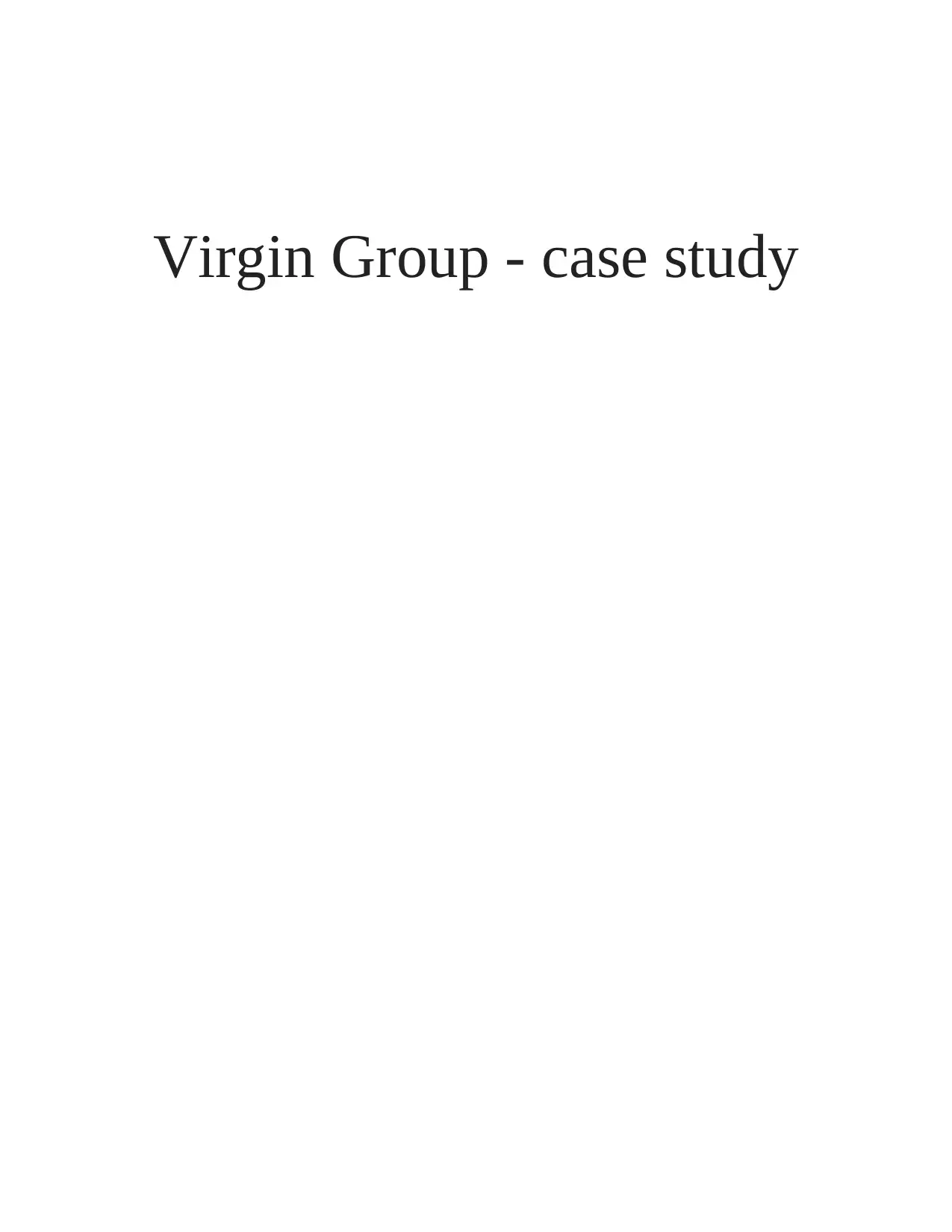
Virgin Group - case study
Paraphrase This Document
Need a fresh take? Get an instant paraphrase of this document with our AI Paraphraser
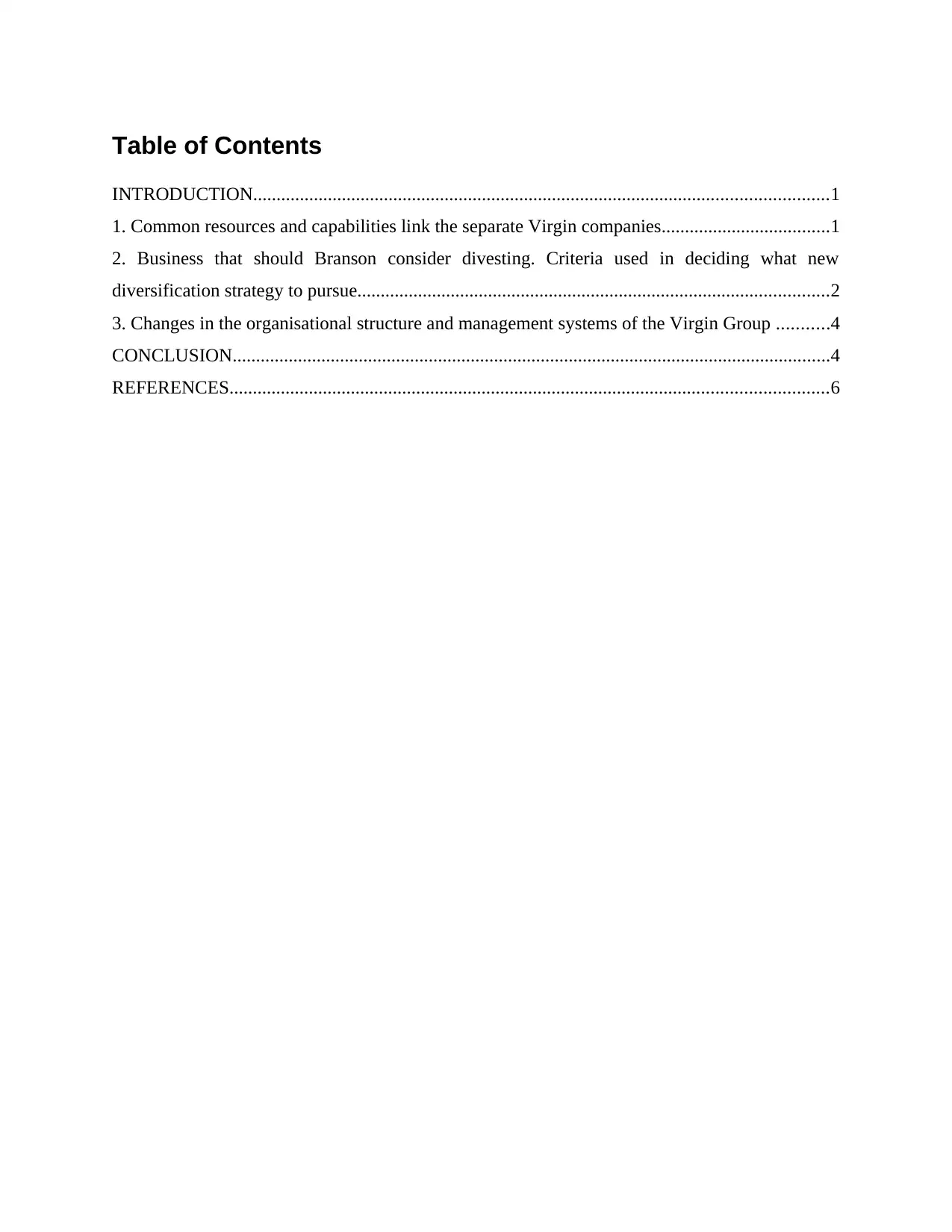
Table of Contents
INTRODUCTION...........................................................................................................................1
1. Common resources and capabilities link the separate Virgin companies....................................1
2. Business that should Branson consider divesting. Criteria used in deciding what new
diversification strategy to pursue.....................................................................................................2
3. Changes in the organisational structure and management systems of the Virgin Group ...........4
CONCLUSION................................................................................................................................4
REFERENCES................................................................................................................................6
INTRODUCTION...........................................................................................................................1
1. Common resources and capabilities link the separate Virgin companies....................................1
2. Business that should Branson consider divesting. Criteria used in deciding what new
diversification strategy to pursue.....................................................................................................2
3. Changes in the organisational structure and management systems of the Virgin Group ...........4
CONCLUSION................................................................................................................................4
REFERENCES................................................................................................................................6
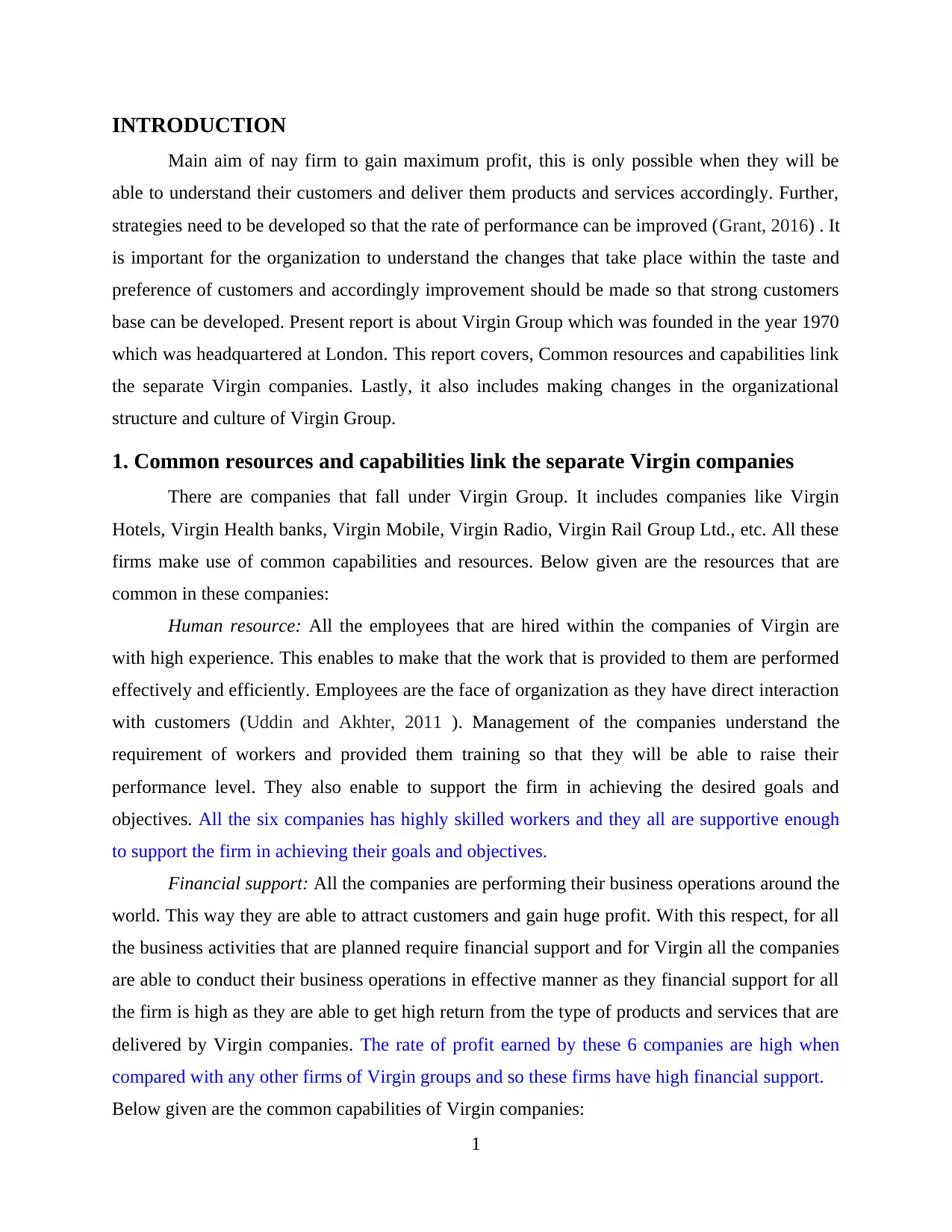
INTRODUCTION
Main aim of nay firm to gain maximum profit, this is only possible when they will be
able to understand their customers and deliver them products and services accordingly. Further,
strategies need to be developed so that the rate of performance can be improved (Grant, 2016) . It
is important for the organization to understand the changes that take place within the taste and
preference of customers and accordingly improvement should be made so that strong customers
base can be developed. Present report is about Virgin Group which was founded in the year 1970
which was headquartered at London. This report covers, Common resources and capabilities link
the separate Virgin companies. Lastly, it also includes making changes in the organizational
structure and culture of Virgin Group.
1. Common resources and capabilities link the separate Virgin companies
There are companies that fall under Virgin Group. It includes companies like Virgin
Hotels, Virgin Health banks, Virgin Mobile, Virgin Radio, Virgin Rail Group Ltd., etc. All these
firms make use of common capabilities and resources. Below given are the resources that are
common in these companies:
Human resource: All the employees that are hired within the companies of Virgin are
with high experience. This enables to make that the work that is provided to them are performed
effectively and efficiently. Employees are the face of organization as they have direct interaction
with customers (Uddin and Akhter, 2011 ). Management of the companies understand the
requirement of workers and provided them training so that they will be able to raise their
performance level. They also enable to support the firm in achieving the desired goals and
objectives. All the six companies has highly skilled workers and they all are supportive enough
to support the firm in achieving their goals and objectives.
Financial support: All the companies are performing their business operations around the
world. This way they are able to attract customers and gain huge profit. With this respect, for all
the business activities that are planned require financial support and for Virgin all the companies
are able to conduct their business operations in effective manner as they financial support for all
the firm is high as they are able to get high return from the type of products and services that are
delivered by Virgin companies. The rate of profit earned by these 6 companies are high when
compared with any other firms of Virgin groups and so these firms have high financial support.
Below given are the common capabilities of Virgin companies:
1
Main aim of nay firm to gain maximum profit, this is only possible when they will be
able to understand their customers and deliver them products and services accordingly. Further,
strategies need to be developed so that the rate of performance can be improved (Grant, 2016) . It
is important for the organization to understand the changes that take place within the taste and
preference of customers and accordingly improvement should be made so that strong customers
base can be developed. Present report is about Virgin Group which was founded in the year 1970
which was headquartered at London. This report covers, Common resources and capabilities link
the separate Virgin companies. Lastly, it also includes making changes in the organizational
structure and culture of Virgin Group.
1. Common resources and capabilities link the separate Virgin companies
There are companies that fall under Virgin Group. It includes companies like Virgin
Hotels, Virgin Health banks, Virgin Mobile, Virgin Radio, Virgin Rail Group Ltd., etc. All these
firms make use of common capabilities and resources. Below given are the resources that are
common in these companies:
Human resource: All the employees that are hired within the companies of Virgin are
with high experience. This enables to make that the work that is provided to them are performed
effectively and efficiently. Employees are the face of organization as they have direct interaction
with customers (Uddin and Akhter, 2011 ). Management of the companies understand the
requirement of workers and provided them training so that they will be able to raise their
performance level. They also enable to support the firm in achieving the desired goals and
objectives. All the six companies has highly skilled workers and they all are supportive enough
to support the firm in achieving their goals and objectives.
Financial support: All the companies are performing their business operations around the
world. This way they are able to attract customers and gain huge profit. With this respect, for all
the business activities that are planned require financial support and for Virgin all the companies
are able to conduct their business operations in effective manner as they financial support for all
the firm is high as they are able to get high return from the type of products and services that are
delivered by Virgin companies. The rate of profit earned by these 6 companies are high when
compared with any other firms of Virgin groups and so these firms have high financial support.
Below given are the common capabilities of Virgin companies:
1
⊘ This is a preview!⊘
Do you want full access?
Subscribe today to unlock all pages.

Trusted by 1+ million students worldwide
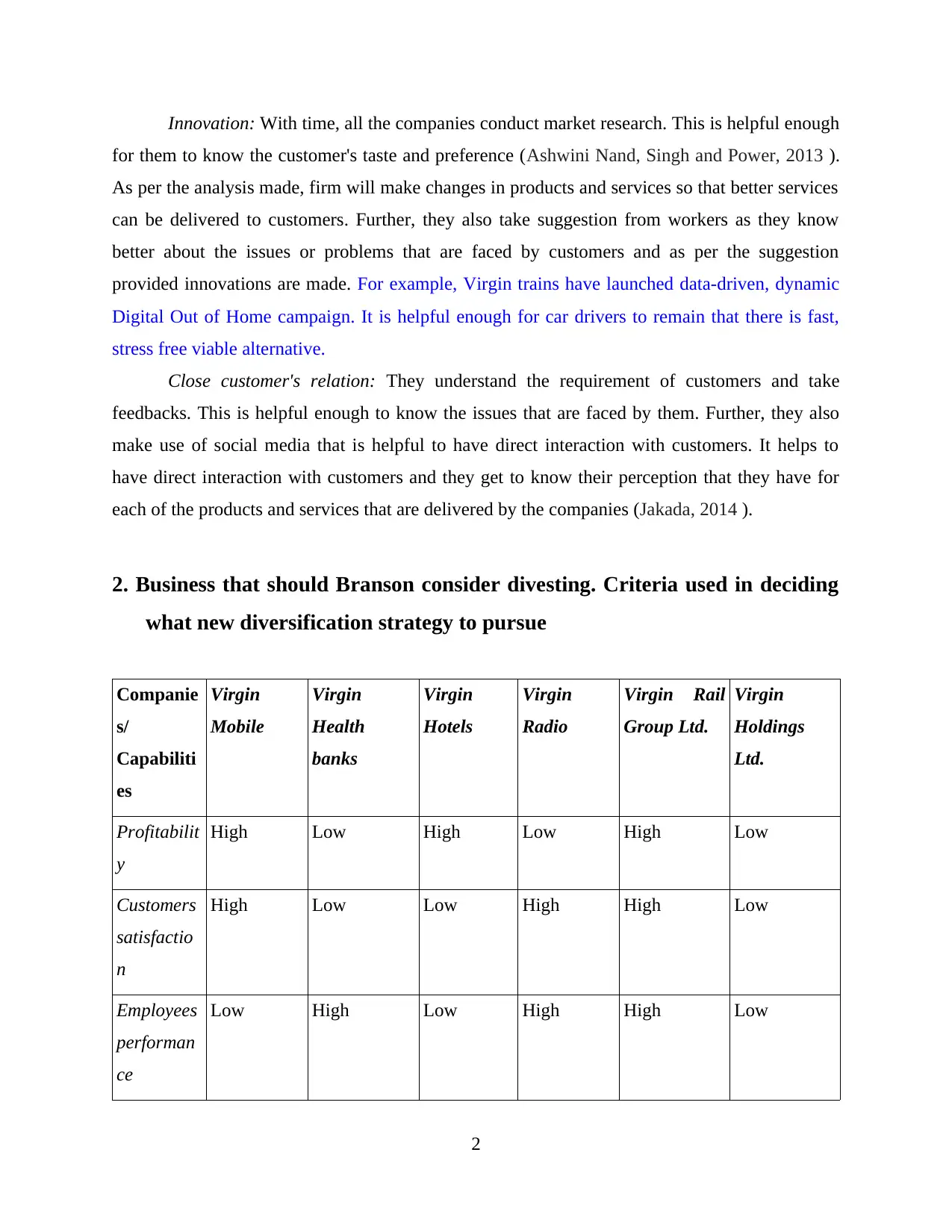
Innovation: With time, all the companies conduct market research. This is helpful enough
for them to know the customer's taste and preference (Ashwini Nand, Singh and Power, 2013 ).
As per the analysis made, firm will make changes in products and services so that better services
can be delivered to customers. Further, they also take suggestion from workers as they know
better about the issues or problems that are faced by customers and as per the suggestion
provided innovations are made. For example, Virgin trains have launched data-driven, dynamic
Digital Out of Home campaign. It is helpful enough for car drivers to remain that there is fast,
stress free viable alternative.
Close customer's relation: They understand the requirement of customers and take
feedbacks. This is helpful enough to know the issues that are faced by them. Further, they also
make use of social media that is helpful to have direct interaction with customers. It helps to
have direct interaction with customers and they get to know their perception that they have for
each of the products and services that are delivered by the companies (Jakada, 2014 ).
2. Business that should Branson consider divesting. Criteria used in deciding
what new diversification strategy to pursue
Companie
s/
Capabiliti
es
Virgin
Mobile
Virgin
Health
banks
Virgin
Hotels
Virgin
Radio
Virgin Rail
Group Ltd.
Virgin
Holdings
Ltd.
Profitabilit
y
High Low High Low High Low
Customers
satisfactio
n
High Low Low High High Low
Employees
performan
ce
Low High Low High High Low
2
for them to know the customer's taste and preference (Ashwini Nand, Singh and Power, 2013 ).
As per the analysis made, firm will make changes in products and services so that better services
can be delivered to customers. Further, they also take suggestion from workers as they know
better about the issues or problems that are faced by customers and as per the suggestion
provided innovations are made. For example, Virgin trains have launched data-driven, dynamic
Digital Out of Home campaign. It is helpful enough for car drivers to remain that there is fast,
stress free viable alternative.
Close customer's relation: They understand the requirement of customers and take
feedbacks. This is helpful enough to know the issues that are faced by them. Further, they also
make use of social media that is helpful to have direct interaction with customers. It helps to
have direct interaction with customers and they get to know their perception that they have for
each of the products and services that are delivered by the companies (Jakada, 2014 ).
2. Business that should Branson consider divesting. Criteria used in deciding
what new diversification strategy to pursue
Companie
s/
Capabiliti
es
Virgin
Mobile
Virgin
Health
banks
Virgin
Hotels
Virgin
Radio
Virgin Rail
Group Ltd.
Virgin
Holdings
Ltd.
Profitabilit
y
High Low High Low High Low
Customers
satisfactio
n
High Low Low High High Low
Employees
performan
ce
Low High Low High High Low
2
Paraphrase This Document
Need a fresh take? Get an instant paraphrase of this document with our AI Paraphraser
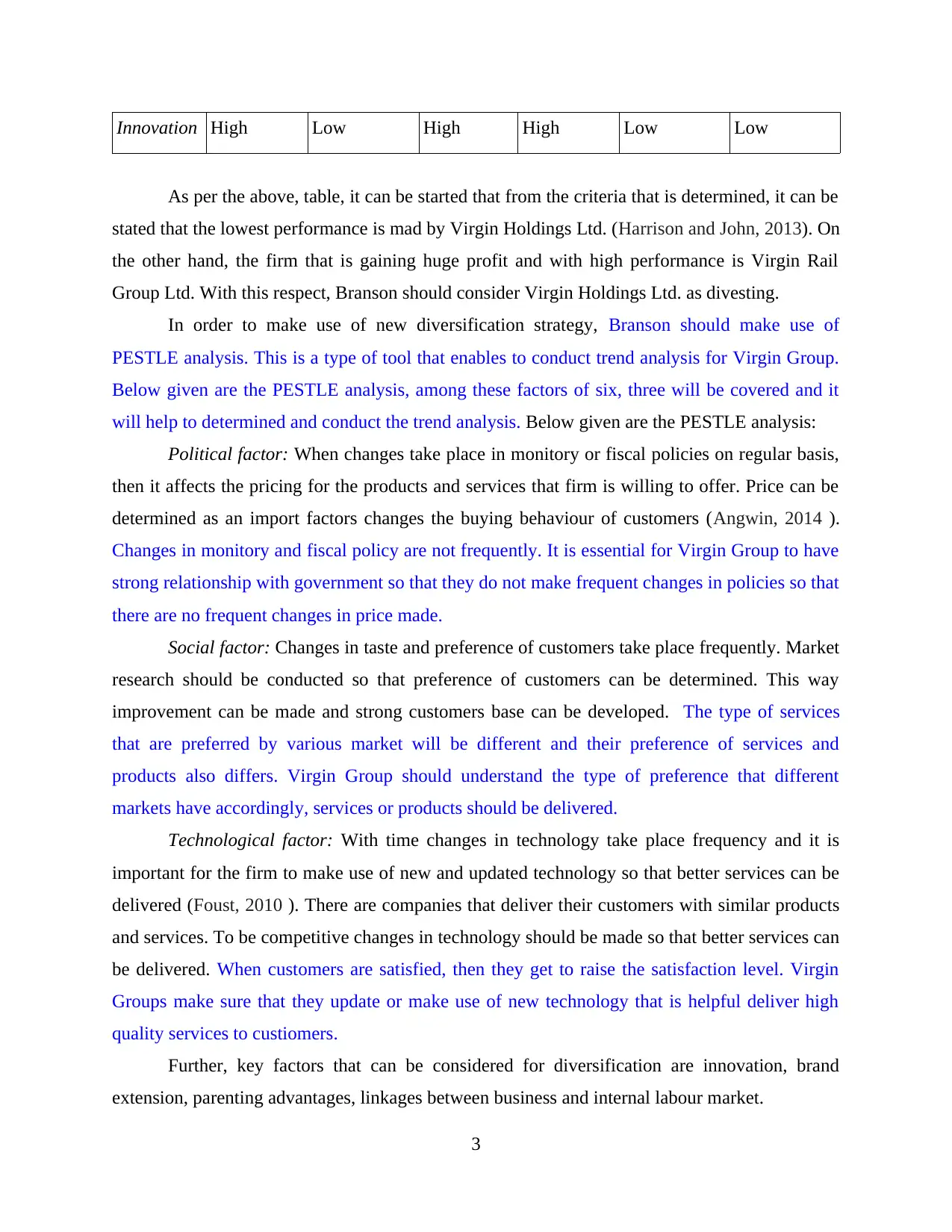
Innovation High Low High High Low Low
As per the above, table, it can be started that from the criteria that is determined, it can be
stated that the lowest performance is mad by Virgin Holdings Ltd. (Harrison and John, 2013). On
the other hand, the firm that is gaining huge profit and with high performance is Virgin Rail
Group Ltd. With this respect, Branson should consider Virgin Holdings Ltd. as divesting.
In order to make use of new diversification strategy, Branson should make use of
PESTLE analysis. This is a type of tool that enables to conduct trend analysis for Virgin Group.
Below given are the PESTLE analysis, among these factors of six, three will be covered and it
will help to determined and conduct the trend analysis. Below given are the PESTLE analysis:
Political factor: When changes take place in monitory or fiscal policies on regular basis,
then it affects the pricing for the products and services that firm is willing to offer. Price can be
determined as an import factors changes the buying behaviour of customers (Angwin, 2014 ).
Changes in monitory and fiscal policy are not frequently. It is essential for Virgin Group to have
strong relationship with government so that they do not make frequent changes in policies so that
there are no frequent changes in price made.
Social factor: Changes in taste and preference of customers take place frequently. Market
research should be conducted so that preference of customers can be determined. This way
improvement can be made and strong customers base can be developed. The type of services
that are preferred by various market will be different and their preference of services and
products also differs. Virgin Group should understand the type of preference that different
markets have accordingly, services or products should be delivered.
Technological factor: With time changes in technology take place frequency and it is
important for the firm to make use of new and updated technology so that better services can be
delivered (Foust, 2010 ). There are companies that deliver their customers with similar products
and services. To be competitive changes in technology should be made so that better services can
be delivered. When customers are satisfied, then they get to raise the satisfaction level. Virgin
Groups make sure that they update or make use of new technology that is helpful deliver high
quality services to custiomers.
Further, key factors that can be considered for diversification are innovation, brand
extension, parenting advantages, linkages between business and internal labour market.
3
As per the above, table, it can be started that from the criteria that is determined, it can be
stated that the lowest performance is mad by Virgin Holdings Ltd. (Harrison and John, 2013). On
the other hand, the firm that is gaining huge profit and with high performance is Virgin Rail
Group Ltd. With this respect, Branson should consider Virgin Holdings Ltd. as divesting.
In order to make use of new diversification strategy, Branson should make use of
PESTLE analysis. This is a type of tool that enables to conduct trend analysis for Virgin Group.
Below given are the PESTLE analysis, among these factors of six, three will be covered and it
will help to determined and conduct the trend analysis. Below given are the PESTLE analysis:
Political factor: When changes take place in monitory or fiscal policies on regular basis,
then it affects the pricing for the products and services that firm is willing to offer. Price can be
determined as an import factors changes the buying behaviour of customers (Angwin, 2014 ).
Changes in monitory and fiscal policy are not frequently. It is essential for Virgin Group to have
strong relationship with government so that they do not make frequent changes in policies so that
there are no frequent changes in price made.
Social factor: Changes in taste and preference of customers take place frequently. Market
research should be conducted so that preference of customers can be determined. This way
improvement can be made and strong customers base can be developed. The type of services
that are preferred by various market will be different and their preference of services and
products also differs. Virgin Group should understand the type of preference that different
markets have accordingly, services or products should be delivered.
Technological factor: With time changes in technology take place frequency and it is
important for the firm to make use of new and updated technology so that better services can be
delivered (Foust, 2010 ). There are companies that deliver their customers with similar products
and services. To be competitive changes in technology should be made so that better services can
be delivered. When customers are satisfied, then they get to raise the satisfaction level. Virgin
Groups make sure that they update or make use of new technology that is helpful deliver high
quality services to custiomers.
Further, key factors that can be considered for diversification are innovation, brand
extension, parenting advantages, linkages between business and internal labour market.
3
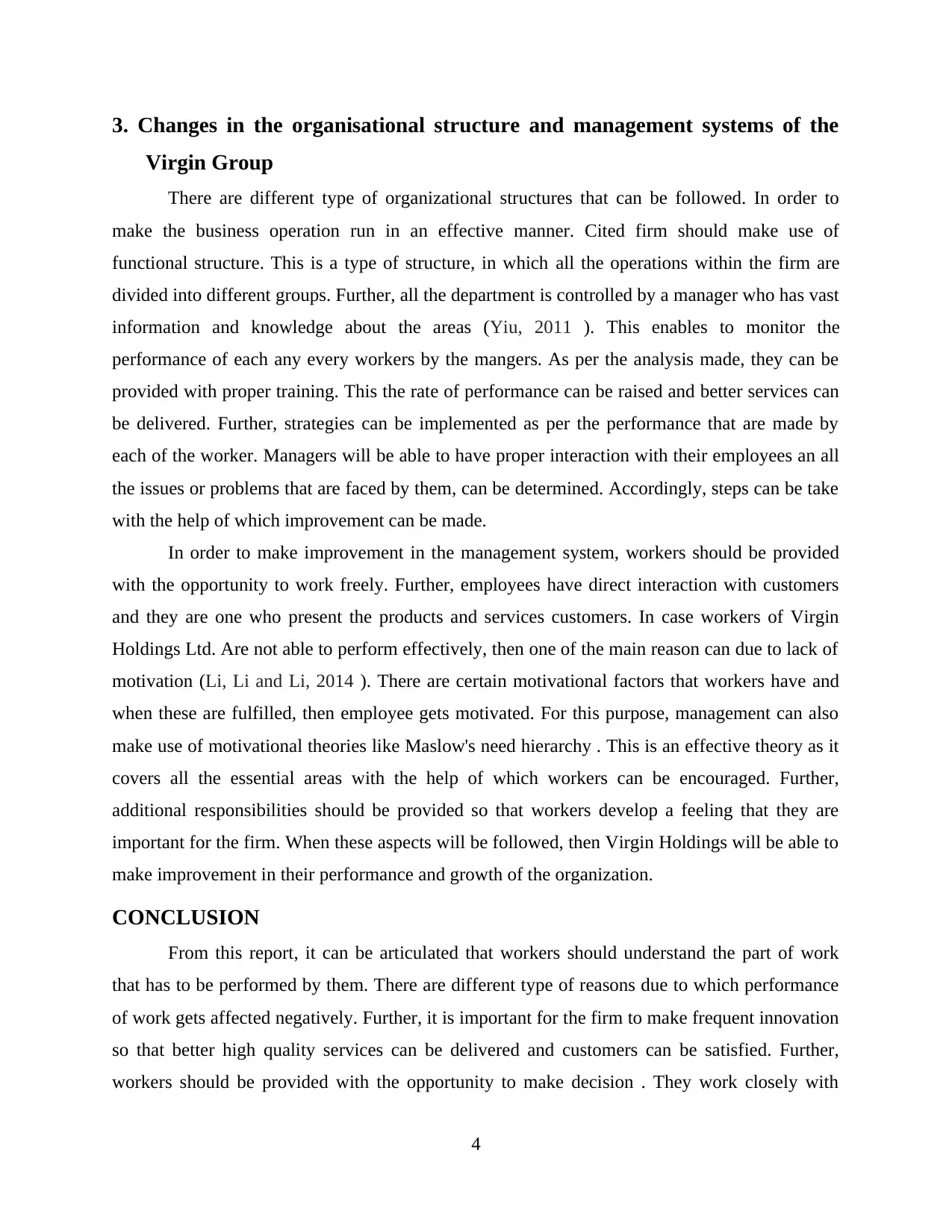
3. Changes in the organisational structure and management systems of the
Virgin Group
There are different type of organizational structures that can be followed. In order to
make the business operation run in an effective manner. Cited firm should make use of
functional structure. This is a type of structure, in which all the operations within the firm are
divided into different groups. Further, all the department is controlled by a manager who has vast
information and knowledge about the areas (Yiu, 2011 ). This enables to monitor the
performance of each any every workers by the mangers. As per the analysis made, they can be
provided with proper training. This the rate of performance can be raised and better services can
be delivered. Further, strategies can be implemented as per the performance that are made by
each of the worker. Managers will be able to have proper interaction with their employees an all
the issues or problems that are faced by them, can be determined. Accordingly, steps can be take
with the help of which improvement can be made.
In order to make improvement in the management system, workers should be provided
with the opportunity to work freely. Further, employees have direct interaction with customers
and they are one who present the products and services customers. In case workers of Virgin
Holdings Ltd. Are not able to perform effectively, then one of the main reason can due to lack of
motivation (Li, Li and Li, 2014 ). There are certain motivational factors that workers have and
when these are fulfilled, then employee gets motivated. For this purpose, management can also
make use of motivational theories like Maslow's need hierarchy . This is an effective theory as it
covers all the essential areas with the help of which workers can be encouraged. Further,
additional responsibilities should be provided so that workers develop a feeling that they are
important for the firm. When these aspects will be followed, then Virgin Holdings will be able to
make improvement in their performance and growth of the organization.
CONCLUSION
From this report, it can be articulated that workers should understand the part of work
that has to be performed by them. There are different type of reasons due to which performance
of work gets affected negatively. Further, it is important for the firm to make frequent innovation
so that better high quality services can be delivered and customers can be satisfied. Further,
workers should be provided with the opportunity to make decision . They work closely with
4
Virgin Group
There are different type of organizational structures that can be followed. In order to
make the business operation run in an effective manner. Cited firm should make use of
functional structure. This is a type of structure, in which all the operations within the firm are
divided into different groups. Further, all the department is controlled by a manager who has vast
information and knowledge about the areas (Yiu, 2011 ). This enables to monitor the
performance of each any every workers by the mangers. As per the analysis made, they can be
provided with proper training. This the rate of performance can be raised and better services can
be delivered. Further, strategies can be implemented as per the performance that are made by
each of the worker. Managers will be able to have proper interaction with their employees an all
the issues or problems that are faced by them, can be determined. Accordingly, steps can be take
with the help of which improvement can be made.
In order to make improvement in the management system, workers should be provided
with the opportunity to work freely. Further, employees have direct interaction with customers
and they are one who present the products and services customers. In case workers of Virgin
Holdings Ltd. Are not able to perform effectively, then one of the main reason can due to lack of
motivation (Li, Li and Li, 2014 ). There are certain motivational factors that workers have and
when these are fulfilled, then employee gets motivated. For this purpose, management can also
make use of motivational theories like Maslow's need hierarchy . This is an effective theory as it
covers all the essential areas with the help of which workers can be encouraged. Further,
additional responsibilities should be provided so that workers develop a feeling that they are
important for the firm. When these aspects will be followed, then Virgin Holdings will be able to
make improvement in their performance and growth of the organization.
CONCLUSION
From this report, it can be articulated that workers should understand the part of work
that has to be performed by them. There are different type of reasons due to which performance
of work gets affected negatively. Further, it is important for the firm to make frequent innovation
so that better high quality services can be delivered and customers can be satisfied. Further,
workers should be provided with the opportunity to make decision . They work closely with
4
⊘ This is a preview!⊘
Do you want full access?
Subscribe today to unlock all pages.

Trusted by 1+ million students worldwide

customers and so they know better about the issues or problems that are faced by workers. In
addition to this, tools like PESTLE and Porters five forces are helpful for the firm to make use of
so that suitable market for business expansion can be selected.
5
addition to this, tools like PESTLE and Porters five forces are helpful for the firm to make use of
so that suitable market for business expansion can be selected.
5
Paraphrase This Document
Need a fresh take? Get an instant paraphrase of this document with our AI Paraphraser
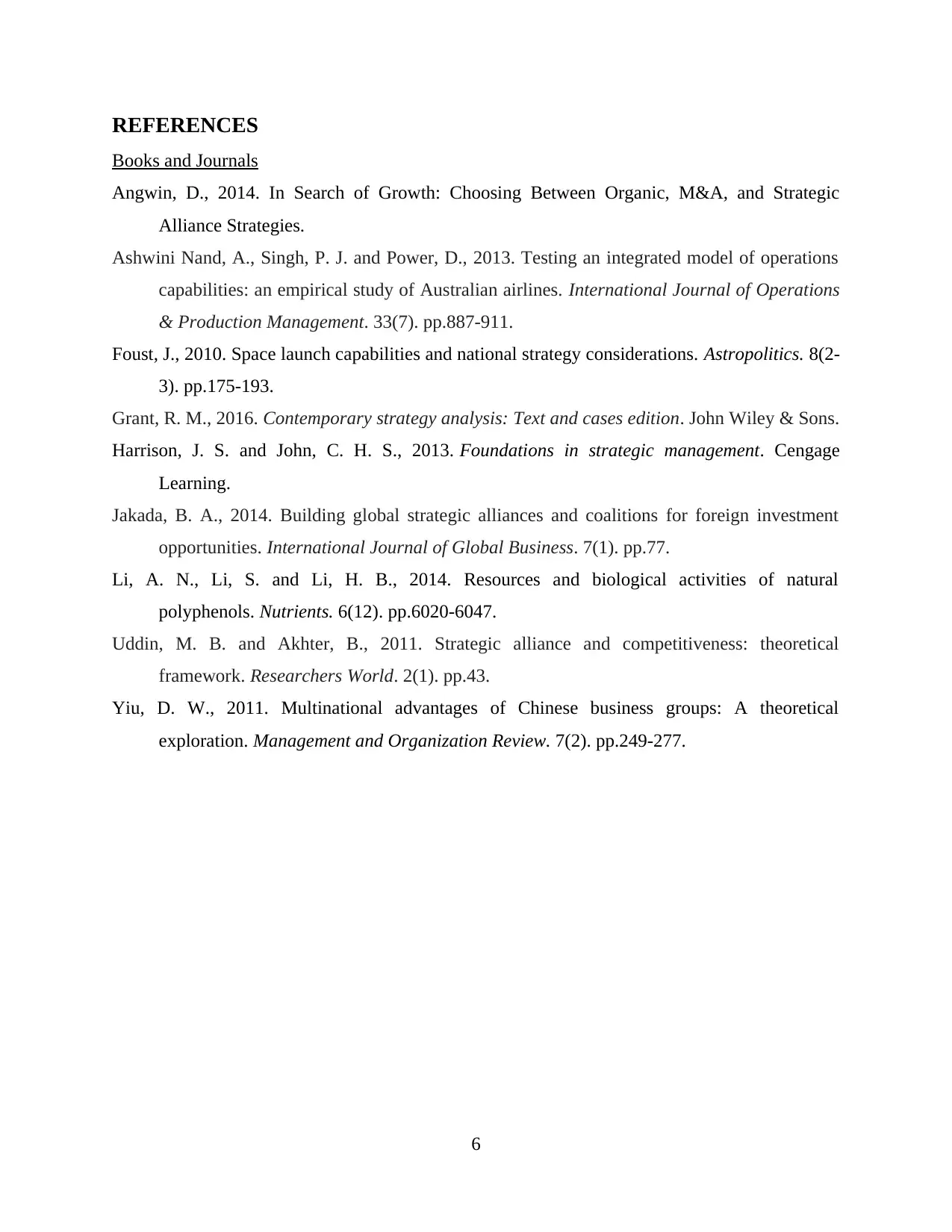
REFERENCES
Books and Journals
Angwin, D., 2014. In Search of Growth: Choosing Between Organic, M&A, and Strategic
Alliance Strategies.
Ashwini Nand, A., Singh, P. J. and Power, D., 2013. Testing an integrated model of operations
capabilities: an empirical study of Australian airlines. International Journal of Operations
& Production Management. 33(7). pp.887-911.
Foust, J., 2010. Space launch capabilities and national strategy considerations. Astropolitics. 8(2-
3). pp.175-193.
Grant, R. M., 2016. Contemporary strategy analysis: Text and cases edition. John Wiley & Sons.
Harrison, J. S. and John, C. H. S., 2013. Foundations in strategic management. Cengage
Learning.
Jakada, B. A., 2014. Building global strategic alliances and coalitions for foreign investment
opportunities. International Journal of Global Business. 7(1). pp.77.
Li, A. N., Li, S. and Li, H. B., 2014. Resources and biological activities of natural
polyphenols. Nutrients. 6(12). pp.6020-6047.
Uddin, M. B. and Akhter, B., 2011. Strategic alliance and competitiveness: theoretical
framework. Researchers World. 2(1). pp.43.
Yiu, D. W., 2011. Multinational advantages of Chinese business groups: A theoretical
exploration. Management and Organization Review. 7(2). pp.249-277.
6
Books and Journals
Angwin, D., 2014. In Search of Growth: Choosing Between Organic, M&A, and Strategic
Alliance Strategies.
Ashwini Nand, A., Singh, P. J. and Power, D., 2013. Testing an integrated model of operations
capabilities: an empirical study of Australian airlines. International Journal of Operations
& Production Management. 33(7). pp.887-911.
Foust, J., 2010. Space launch capabilities and national strategy considerations. Astropolitics. 8(2-
3). pp.175-193.
Grant, R. M., 2016. Contemporary strategy analysis: Text and cases edition. John Wiley & Sons.
Harrison, J. S. and John, C. H. S., 2013. Foundations in strategic management. Cengage
Learning.
Jakada, B. A., 2014. Building global strategic alliances and coalitions for foreign investment
opportunities. International Journal of Global Business. 7(1). pp.77.
Li, A. N., Li, S. and Li, H. B., 2014. Resources and biological activities of natural
polyphenols. Nutrients. 6(12). pp.6020-6047.
Uddin, M. B. and Akhter, B., 2011. Strategic alliance and competitiveness: theoretical
framework. Researchers World. 2(1). pp.43.
Yiu, D. W., 2011. Multinational advantages of Chinese business groups: A theoretical
exploration. Management and Organization Review. 7(2). pp.249-277.
6
1 out of 8
Related Documents
Your All-in-One AI-Powered Toolkit for Academic Success.
+13062052269
info@desklib.com
Available 24*7 on WhatsApp / Email
![[object Object]](/_next/static/media/star-bottom.7253800d.svg)
Unlock your academic potential
Copyright © 2020–2025 A2Z Services. All Rights Reserved. Developed and managed by ZUCOL.





